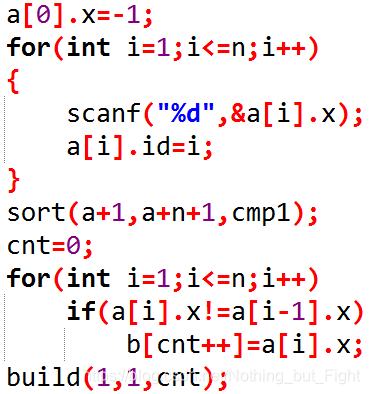POJ 2299-Ultra-QuickSort-线段树的两种建树方式
2019-08-16 07:59:36来源:博客园 阅读 ()

POJ 2299-Ultra-QuickSort-线段树的两种建树方式
此题有两种建树方式!
Description
In this problem, you have to analyze a particular sorting algorithm. The algorithm processes a sequence of n distinct integers by swapping two adjacent sequence elements until the sequence is sorted in ascending order.
For the input sequence
9 1 0 5 4 ,
Ultra-QuickSort produces the output
0 1 4 5 9 .
Your task is to determine how many swap operations Ultra-QuickSort needs to perform in order to sort a given input sequence.
Input
The input contains several test cases. Every test case begins with a line that contains a single integer n < 500,000 -- the length of the input sequence. Each of the the following n lines contains a single integer 0 ≤ a[i] ≤ 999,999,999, the i-th input sequence element. Input is terminated by a sequence of length n = 0. This sequence must not be processed.
Output
For every input sequence, your program prints a single line containing an integer number op, the minimum number of swap operations necessary to sort the given input sequence.
Sample Input
5
9
1
0
5
4
3
1
2
3
0Sample Output
6
0题目大意:
给定一个排列,求这个排列的逆序数。
逆序的定义
在一个排列中,如果一对数的前后位置与大小顺序相反,即前面的数大于后面的数,那么它们就称为一个逆序。
核心思想:
我们用结构体来存储排列:

a[i].x表示第i个数的数值,a[i].id表示第i个数的位置。
对于每一个数a[i].x,我们找到位置在它前面并且数值比它大的数的个数c[i],c数组的和就是答案。
线段树。
我们在统计个数的时候,数要满足两个条件:
1、位置在它前面
2、数值比它大
我们在空间和时间上分别加以控制来满足这两个条件。
空间:线段树的左右区间。
时间:线段树的更新顺序。
所以此题有两种建树方式,
方式一
从空间上加以控制来满足位置在它前面的条件;
从时间上加以控制来满足数值比它大的条件。
线段树的左右区间表示原排列中数的位置,通过控制查询时左右区间的端点来满足位置在它前面的条件。
我们将a数组按x降序排列,按照新的顺序依次更新线段树,数值的大的先进入(更新)线段树,所以现在从线段树上查询到的个数一定满足数值比它大的条件。
此方式建树不需要离散化,下面的方式需要离散化。
方式二
从空间上加以控制来满足数值比它大的条件;
从时间上加以控制来满足位置在它前面的条件。
线段树的左右区间表示原排列中数的数值,通过控制查询时左右区间的端点来满足数值比它大的条件。
我们将a数组按id升序排列(也就是原顺序),位置靠前的先进入(更新)线段树,所以现在从线段树上查询到的个数一定满足位置在它前面的条件。
注意:此题目数的数值范围是1e10,将数值作为线段树区间长度开不出这么大的数组。解决方法是离散化。

离散前后的映射函数是:

离散后的数值范围是不同数值的个数,也就是5e5。这样就可以开数组建树了。
方式一代码:
#include<cstdio>
#include<iostream>
#include<algorithm>
using namespace std;
typedef long long ll;
const int N=5e5+20;
char s[20];
//存原排列
struct node{
int x,id;
}a[N];
struct tnode{
int l,r,sum;
}tr[N<<2];
void pushup(int m)
{
tr[m].sum=tr[m<<1].sum+tr[m<<1|1].sum;
return;
}
void build(int m,int l,int r)
{
tr[m].l=l;
tr[m].r=r;
if(l==r)
{
tr[m].sum=0;
return;
}
int mid=(l+r)>>1;
build(m<<1,l,mid);
build(m<<1|1,mid+1,r);
pushup(m);
return;
}
void update(int m,int x)
{
if(tr[m].l==x&&tr[m].r==x)
{
tr[m].sum=1;
return;
}
int mid=(tr[m].l+tr[m].r)>>1;
if(x<=mid)
update(m<<1,x);
else
update(m<<1|1,x);
pushup(m);
return;
}
int query(int m,int l,int r)
{
if(tr[m].l==l&&tr[m].r==r)
return tr[m].sum;
int mid=(tr[m].l+tr[m].r)>>1;
if(r<=mid)
return query(m<<1,l,r);
if(l>mid)
return query(m<<1|1,l,r);
return query(m<<1,l,mid)+query(m<<1|1,mid+1,r);
}
bool cmp(node p,node q)
{
return p.x>q.x;
}
int main()
{
int n;
while(1)
{
scanf("%d",&n);
if(!n)
break;
//根据n直接建树
build(1,1,n);
//输入
for(int i=1;i<=n;i++)
{
scanf("%d",&a[i].x);
a[i].id=i;
}
//排序,x大的先进入线段树
sort(a+1,a+n+1,cmp);
//边更新边查询
ll ans=0;
for(int i=1;i<=n;i++)
{
ans+=query(1,1,a[i].id);
update(1,a[i].id);
}
//输出
printf("%lld\n",ans);
}
return 0;
}方式二代码:
#include<cstdio>
#include<iostream>
#include<algorithm>
using namespace std;
typedef long long ll;
const int N=5e5+20;
int b[N],cnt;
//存原排列
struct node{
int x,id;
}a[N];
struct tnode{
int l,r,sum;
}tr[N<<2];
void pushup(int m)
{
tr[m].sum=tr[m<<1].sum+tr[m<<1|1].sum;
return;
}
void build(int m,int l,int r)
{
tr[m].l=l;
tr[m].r=r;
if(l==r)
{
tr[m].sum=0;
return;
}
int mid=(l+r)>>1;
build(m<<1,l,mid);
build(m<<1|1,mid+1,r);
pushup(m);
return;
}
void update(int m,int x)
{
if(tr[m].l==x&&tr[m].r==x)
{
tr[m].sum=1;
return;
}
int mid=(tr[m].l+tr[m].r)>>1;
if(x<=mid)
update(m<<1,x);
else
update(m<<1|1,x);
pushup(m);
return;
}
int query(int m,int l,int r)
{
if(tr[m].l==l&&tr[m].r==r)
return tr[m].sum;
int mid=(tr[m].l+tr[m].r)>>1;
if(r<=mid)
return query(m<<1,l,r);
if(l>mid)
return query(m<<1|1,l,r);
return query(m<<1,l,mid)+query(m<<1|1,mid+1,r);
}
bool cmp1(node p,node q)
{
return p.x<q.x;
}
bool cmp2(node p,node q)
{
return p.id<q.id;
}
int getid(int x)
{
return lower_bound(b,b+cnt,x)-b+1;
}
int main()
{
int n;
while(1)
{
scanf("%d",&n);
if(!n)
break;
//输入
a[0].x=-1;
for(int i=1;i<=n;i++)
{
scanf("%d",&a[i].x);
a[i].id=i;
}
//先离散化
sort(a+1,a+n+1,cmp1);
cnt=0;
for(int i=1;i<=n;i++)
if(a[i].x!=a[i-1].x)
b[cnt++]=a[i].x;
//根据离散后的cnt建树
build(1,1,cnt);
//别忘了把a数组sort回来
sort(a+1,a+n+1,cmp2);
//边更新边查询
ll ans=0;
for(int i=1;i<=n;i++)
{
int t=getid(a[i].x);
ans+=query(1,t,n);
update(1,t);
}
//输出
printf("%lld\n",ans);
}
return 0;
}原文链接:https://www.cnblogs.com/NothingbutFight/p/11306760.html
如有疑问请与原作者联系
标签:
版权申明:本站文章部分自网络,如有侵权,请联系:west999com@outlook.com
特别注意:本站所有转载文章言论不代表本站观点,本站所提供的摄影照片,插画,设计作品,如需使用,请与原作者联系,版权归原作者所有
- 【数据结构】树套树——线段树套平衡树 2020-04-18
- POJ-3278 2020-04-01
- 线段树学习资料 2020-03-19
- 排兵布阵 2020-02-21
- Asteroids!_poj2225 2020-02-09
IDC资讯: 主机资讯 注册资讯 托管资讯 vps资讯 网站建设
网站运营: 建站经验 策划盈利 搜索优化 网站推广 免费资源
网络编程: Asp.Net编程 Asp编程 Php编程 Xml编程 Access Mssql Mysql 其它
服务器技术: Web服务器 Ftp服务器 Mail服务器 Dns服务器 安全防护
软件技巧: 其它软件 Word Excel Powerpoint Ghost Vista QQ空间 QQ FlashGet 迅雷
网页制作: FrontPages Dreamweaver Javascript css photoshop fireworks Flash
